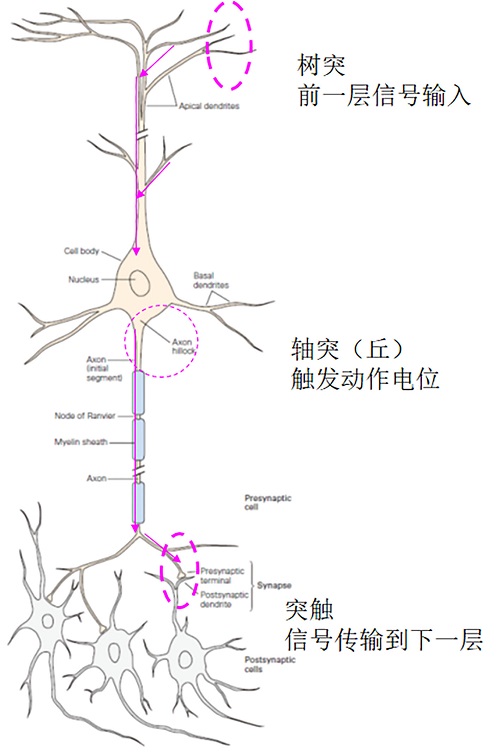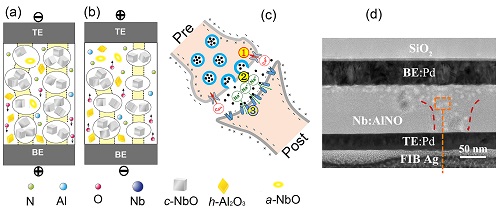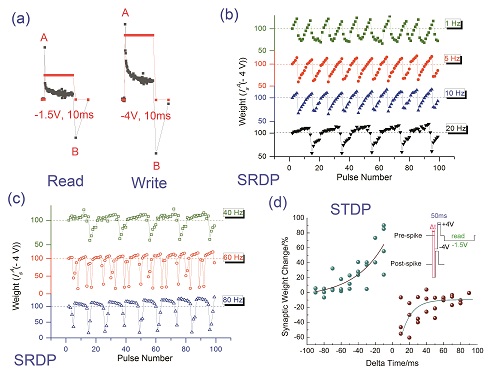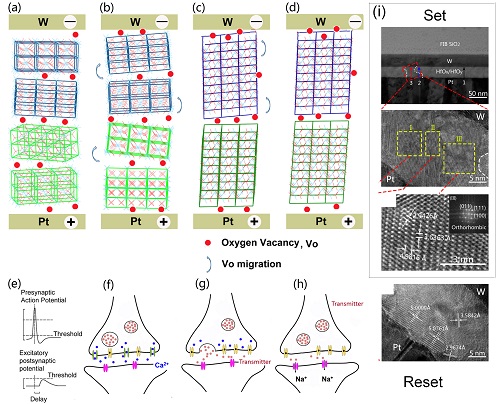1. Wan, Q.; Zeng, F.; Yin, J.; Sun, Y. M.; Hu, Y. D.; Liu, J. L.; Wang, Y. C.; Li, G. Q.; Guo, D.; Pan, F., Phase-change Nano-clusters Embedded Memristor for Simulating Synaptic Learning. Nanoscale 2019, 11, 5684-5692.
2. Yin, J.; Zeng, F.; Wan, Q.; Li, F.; Sun, Y. M.; Hu, Y. D.; Liu, J. L.; Li, G. Q.; Pan, F., Adaptive Crystallite Kinetics in Homogenous Bilayer Oxide Memristor for Emulating Diverse Synaptic Plasticity. Adv. Funct. Mater. 2018, 28, 1706927.
3. Hu, Y. D.; Zeng, F.; Chang, C. T.; Dong, W. S.; Li, X. J.; Pan, F.; Li, G. Q., Diverse Synaptic Plasticity Induced by Interplay of Ionic Polarization and Doping at Salt-Doped Electrolyte/Semiconducting Polymer Interface. ACS Omega 2017, 2, 746-754.
4. Chang, C. T.; Zeng, F.; Li, J. X.; Dong, W. S.; Hu, Y. D.; Li, G. Q., Spatial summation of the short-term plasticity of a pair of organic heterogeneous junctions. RSC Adv. 2017, 7, 4017.
5. Chang, C. T.; Zeng, F.; Li, X. J.; Dong, W. S.; Lu, S. H.; Gao, S.; Pan, F., Simulation of synaptic short-term plasticity using Ba(CF3SO3)2-doped polyethylene oxide electrolyte film. Sci. Rep. 2016, 5, 18915.
6. Dong, W. S.; Zeng, F.; Lu, S. H.; Liu, A.; Li, X. J.; Pan, F., Frequency-dependent learning achieved using semiconducting polymer/electrolyte composite cells. Nanoscale 2015, 7, 16880 - 16889.
7. Tang, G. S.; Zeng, F.; Chen, C.; Liu, H. Y.; Gao, S.; Song, C.; Lin, Y. S.; Chen, G.; Pan, F., Programmable complementary resistive switching behaviours of a plasma-oxidised titanium oxide nanolayer. Nanoscale 2013, 5, 422-428.
8. Gao, S.; Zeng, F.; Li, F.; Wang, M. J.; Mao, H. J.; Wang, G. Y.; Song, C.; Pan, F., forming-free and self-rectifying resistive switching of the simple Pt/TaOx/n-Si structure for access device-free high-density memory application. Nanoscale 2015, 7, 6031-6038.
9. Li, S. Z.; Zeng, F.; Chen, C.; Liu, H.; Tang, G. S.; Gao, S.; Song, C.; Lin, Y. S.; Pan, F.; Guo, D., Synaptic plasticity and learning behaviours mimicked through Ag interface movement in an Ag/conducting polymer/Ta memristive system. J. Mater. Chem. C 2013, 1, 5292-5298.
10. Wang, Z. S.; Zeng, F.; Yang, J.; Chen, C.; Pan, F., Resistive switching induced by metallic filaments formation through poly (3, 4-ethylene-dioxythiophene): poly (styrenesulfonate). ACS Appl. Mater. & Interfaces 2012, 4, 447-453.
11. Zeng, F.; Li, S. Z.; Yang, J.; Pan, F.; Guo, D., Learning processes modulated by the interface effects in a Ti/conducting polymer/Ti resistive switching cell. RSC Adv. 2014, 4, 14822.
12. Zeng, F.; Lu, S. H.; Li, S. Z.; Li, X. J.; Pan, F., Frequency Selectivity in Pulse Responses of Pt/Poly(3-Hexylthiophene-2,5-Diyl)/Polyethylene Oxide + Li+/Pt Hetero-Junction. PLoS ONE 2014, 9, e108316.
13. Wang, Z. S.; Zeng, F.; Yang, J.; Chen, C.; Yang, Y. C.; Pan, F., Reproducible and controllable organic resistive memory based on Al/poly(3,4-ethylene-dioxythiophene):poly(styrenesulfonate)/Al structure. Appl. Phys. Lett. 2010, 97, 253301.
14. Chen, C.; Gao, S.; Zeng, F.; Wang, G. Y.; Li, S. Z.; Song, C.; Pan, F., Conductance quantization in oxygen-anion-migration-based resistive switching memory devices. Appl. Phys. Lett. 2013, 103, 043510.
15. Gao, S.; Zeng, F.; Wang, M. J.; Wang, G. Y.; Song, C.; Pan, F., Implementation of Complete Boolean Logic Functions in Single Complementary Resistive Switch. Sci. Rep. 2015, 5, 15467.
Interesting Topics
1. Brain-Inspired Materials And Devices

Currently, it is applicable to use artificial materials & devices, such as memristor materials and devices, to mimic signal evoking, i.e., action potential, in neuron and synaptic plasticity in synapse. It is also possible to construct an intact neural loop with memristor devices.

We have found a type of phase-change nanocluster embedded memristor system. It consists of cubic NbO nano-cluster to form conducting filament in the matrix. The nano-clusters can vary between crystalline and amorphous phase depending on the environment temperature and heat accumulation induced by electrical current. The nano-clusters are capable of mimicking and controlling gate-controlled ionic channel in biology.

We have mimicked conventional synaptic plasticity in neuroscience, i.e. SRDP and STDP, and corresponding learning modes. We also have found that the system can evoke action potential similar to that in biology. Therefore, the Nb-doped AlNO system, which consists of phase-change nano-clusters, can either mimic synapse or neuron. The artificial neural loop can be constructed by using this type of elementary cells.
(Wan, Q.; Zeng, F.; Yin, J.; Sun, Y. M.; Hu, Y. D.; Liu, J. L.; Wang, Y. C.; Li, G. Q.; Guo, D.; Pan, F., Phase-change Nano-clusters Embedded Memristor for Simulating Synaptic Learning. Nanoscale 2019, 11, 5684-5692).

We have used HfOx based memristive system consisting of double HfOx layers to simulate switching of ionic channel by using crystalline rotation microscopically. We have also mimicked SRDP.
(Yin, J.; Zeng, F.; Wan, Q.; Li, F.; Sun, Y. M.; Hu, Y. D.; Liu, J. L.; Li, G. Q.; Pan, F., Adaptive Crystallite Kinetics in Homogenous Bilayer Oxide Memristor for Emulating Diverse Synaptic Plasticity. Adv. Funct. Mater. 2018, 28, 1706927.)